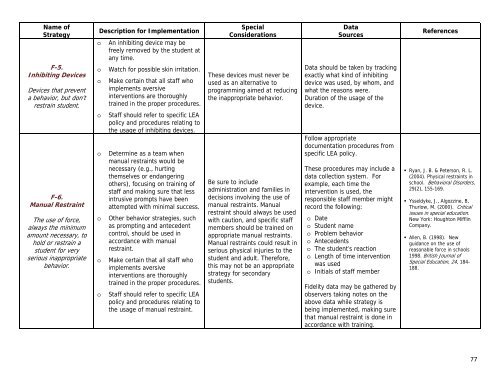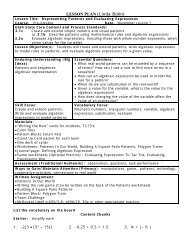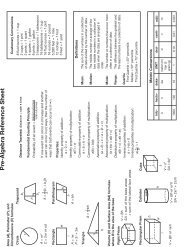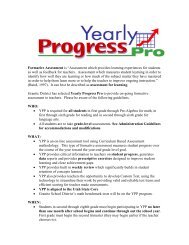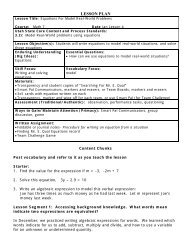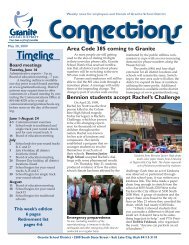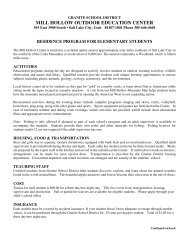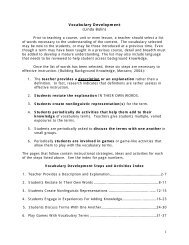Utah's Least Restrictive Behavioral Interventions Guidelines
Utah's Least Restrictive Behavioral Interventions Guidelines
Utah's Least Restrictive Behavioral Interventions Guidelines
Create successful ePaper yourself
Turn your PDF publications into a flip-book with our unique Google optimized e-Paper software.
Name of<br />
Strategy<br />
F-5.<br />
Inhibiting Devices<br />
Devices that prevent<br />
a behavior, but don’t<br />
restrain student.<br />
F-6.<br />
Manual Restraint<br />
The use of force,<br />
always the minimum<br />
amount necessary, to<br />
hold or restrain a<br />
student for very<br />
serious inappropriate<br />
behavior.<br />
Description for Implementation<br />
o<br />
o<br />
o<br />
o<br />
o<br />
o<br />
o<br />
o<br />
An inhibiting device may be<br />
freely removed by the student at<br />
any time.<br />
Watch for possible skin irritation.<br />
Make certain that all staff who<br />
implements aversive<br />
interventions are thoroughly<br />
trained in the proper procedures.<br />
Staff should refer to specific LEA<br />
policy and procedures relating to<br />
the usage of inhibiting devices.<br />
Determine as a team when<br />
manual restraints would be<br />
necessary (e.g., hurting<br />
themselves or endangering<br />
others), focusing on training of<br />
staff and making sure that less<br />
intrusive prompts have been<br />
attempted with minimal success.<br />
Other behavior strategies, such<br />
as prompting and antecedent<br />
control, should be used in<br />
accordance with manual<br />
restraint.<br />
Make certain that all staff who<br />
implements aversive<br />
interventions are thoroughly<br />
trained in the proper procedures.<br />
Staff should refer to specific LEA<br />
policy and procedures relating to<br />
the usage of manual restraint.<br />
Special<br />
Considerations<br />
These devices must never be<br />
used as an alternative to<br />
programming aimed at reducing<br />
the inappropriate behavior.<br />
Be sure to include<br />
administration and families in<br />
decisions involving the use of<br />
manual restraints. Manual<br />
restraint should always be used<br />
with caution, and specific staff<br />
members should be trained on<br />
appropriate manual restraints.<br />
Manual restraints could result in<br />
serious physical injuries to the<br />
student and adult. Therefore,<br />
this may not be an appropriate<br />
strategy for secondary<br />
students.<br />
Data<br />
Sources<br />
Data should be taken by tracking<br />
exactly what kind of inhibiting<br />
device was used, by whom, and<br />
what the reasons were.<br />
Duration of the usage of the<br />
device.<br />
Follow appropriate<br />
documentation procedures from<br />
specific LEA policy.<br />
These procedures may include a<br />
data collection system. For<br />
example, each time the<br />
intervention is used, the<br />
responsible staff member might<br />
record the following:<br />
o Date<br />
o Student name<br />
o Problem behavior<br />
o Antecedents<br />
o The student’s reaction<br />
o Length of time intervention<br />
was used<br />
o Initials of staff member<br />
Fidelity data may be gathered by<br />
observers taking notes on the<br />
above data while strategy is<br />
being implemented, making sure<br />
that manual restraint is done in<br />
accordance with training.<br />
References<br />
• Ryan, J. B. & Peterson, R. L.<br />
(2004). Physical restraints in<br />
school. <strong>Behavioral</strong> Disorders,<br />
29(2), 155-169.<br />
• Ysseldyke, J., Algozzine, B,<br />
Thurlow, M. (2000). Critical<br />
issues in special education.<br />
New York: Houghton Mifflin<br />
Company.<br />
• Allen, B. (1998). New<br />
guidance on the use of<br />
reasonable force in schools<br />
1998. British Journal of<br />
Special Education, 24, 184-<br />
188.<br />
77


